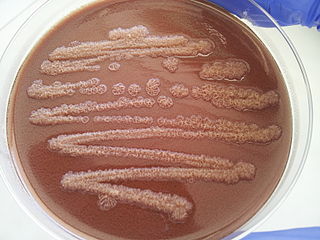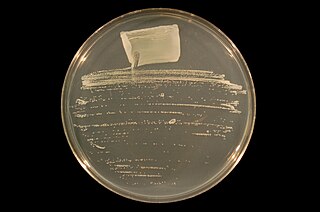
Pseudomonas stutzeri is a Gram-negative soil bacterium that is motile, has a single polar flagellum, and is classified as bacillus, or rod-shaped. While this bacterium was first isolated from human spinal fluid, it has since been found in many different environments due to its various characteristics and metabolic capabilities. P. stutzeri is an opportunistic pathogen in clinical settings, although infections are rare. Based on 16S rRNA analysis, this bacterium has been placed in the P. stutzeri group, to which it lends its name.

Bradyrhizobium is a genus of Gram-negative soil bacteria, many of which fix nitrogen. Nitrogen fixation is an important part of the nitrogen cycle. Plants cannot use atmospheric nitrogen (N2); they must use nitrogen compounds such as nitrates.

Ensifer is a genus of nitrogen-fixing bacteria (rhizobia), three of which have been sequenced.
"Aromatoleum" is a genus of bacteria capable of microbial biodegradation of organic pollutants. It has one single described species member, A. aromaticum, for which the only strain is strain EbN1.
Ensifer fredii is a nitrogen fixing bacteria of the genus Sinorhizobium. It is a fast-growing root nodule bacteria. Sinorhizobium fredii exhibit a broad host-range and are able to nodulate both determinant hosts such as soy as well as indeterminate hosts including the pigeon pea. Because of their ease of host infection there is interest in their genetics and the symbiotic role in host infection and nodule formation.

Azospirillum brasilense is a well studied, nitrogen-fixing (diazotroph), genetically tractable, Gram-negative, alpha-proteobacterium bacterium, first described in Brazil by the group of Johanna Döbereiner and then receiving the name "brasilense". A. brasilense is able to fix nitrogen in the presence of low oxygen levels, making it a microaerobic diazotroph. An isolate from the genus Azospirillum was isolated from nitrogen poor soils in the Netherlands in 1925, however the species A. brasilense was first described in 1978 in Brazil, since this genus is widely found in the rhizospheres of grasses around the world where it confers plant growth promotion. Whether growth promotion occurs through direct nitrogen flux from the bacteria to the plant or through hormone regulation is debated. The two most commonly studied strains are Sp7 and Sp245, both are Brazilian isolates isolated from Tropical grasses from Seropedica, Brazil.
Azoarcus communis is a species of bacteria. It is a nitrogen-fixing bacteria. Its cells are yellow-pigmented, straight to curved, gram-negative rods. Its type strain is LMG 5514.
Azoarcus olearius is a species of bacteria. It is a nitrogen-fixing bacteria. Its cells are Gram-negative, motile and rod-shaped, surrounded by a thin capsule. Its type strain is DQS-4T.
Azoarcus is a genus of nitrogen-fixing bacteria. Species in this genus are usually found in contaminated water, as they are involved in the degradation of some contaminants, commonly inhabiting soil. These bacteria have also been found growing in the endophytic compartment of some rice species and other grasses. The genus is within the family Zoogloeaceae in the Rhodocyclales of the Betaproteobacteria.
Azoarcus tolulyticus is a species of bacteria. It is a nitrogen-fixing bacteria. It is notable for degrading toluene. Tol-4 is its type strain.
Azovibrio restrictus is a species of bacteria. It is a root bacteria and is the only known species of its genus.
Azospira oryzae is a species of bacteria. It is a root bacteria, one of two species in the genus Azospira along with A. restricta.
Azonexus fungiphilus is a species of bacteria. It is a root bacteria and together with Azonexus caeni is one of the two species in the genus.
Azospirillum halopraeferens is a species of nitrogen-fixing bacteria associated with the roots of Diplachne fusca and black mangrove. It is microaerophilic and its type strain is Au 4.
Azospirillum doebereinerae is a species of nitrogen-fixing bacteria associated with the roots of Miscanthus species. Its type strain is GSF71T.
Ensifer medicae is a species of gram-negative, nitrogen-fixing, rod-shaped bacteria. They can be free-living or symbionts of leguminous plants in root nodules. E.medicae was first isolated from root nodules on plants in the genus Medicago. Some strains of E.medicae, like WSM419, are aerobic. They are chemoorganotrophic mesophiles that prefer temperatures around 28 °C. In addition to their primary genome, these organisms also have three known plasmids, sized 1,570,951 bp, 1,245,408 bp and 219,313 bp.
Xanthobacter agilis is a dinitrogen-fixing, non-pleomorphic hydrogen-oxidizing and motile bacteria from the family of Xanthobacteraceae which has been isolated from a lake near Neuchâtel in Switzerland. Xanthobacter agilis produces o-phthalyl amidase.
Sphingomonas azotifigens is a nitrogen-fixing bacteria from the genus of Sphingomonas which has been isolated from the root of a rice plant in Mishima in Japan.
Azospirillum is a Gram-negative, microaerophilic, non-fermentative and nitrogen-fixing bacterial genus from the family of Rhodospirillaceae. Azospirillum bacteria can promote plant growth.

Phytobacter is a genus of Gram-negative bacteria emerging from the grouping of isolates previously assigned to various genera of the family Enterobacteriaceae. This genus was first established on the basis of nitrogen fixing isolates from wild rice in China, but also includes a number of isolates obtained during a 2013 multi-state sepsis outbreak in Brazil and, retrospectively, several clinical strains isolated in the 1970s in the United States that are still available in culture collections, which originally were grouped into Brenner's Biotype XII of the Erwinia herbicola-Enterobacter agglomerans-Complex (EEC). Standard biochemical evaluation panels are lacking Phytobacter spp. from their database, thus often leading to misidentifications with other Enterobacterales species, especially Pantoea agglomerans. Clinical isolates of the species have been identified as an important source of extended-spectrum β-lactamase and carbapenem-resistance genes, which are usually mediated by genetic mobile elements. Strong protection of co-infecting sensitive bacteria has also been reported. Bacteria belonging to this genus are not pigmented, chemoorganotrophic and able to fix nitrogen. They are lactose fermenting, cytochrome-oxidase negative and catalase positive. Glucose is fermented with the production of gas. Colonies growing on MacConkey agar (MAC) are circular, convex and smooth with non-entire margins and a usually elevated center. Three species are currently validly included in the genus Phytobacter, which is still included within the Kosakonia clade in the lately reviewed family of Enterobacteriaceae. The incorporation of a fourth species, Phytobacter massiliensis, has recently been proposed via the unification of the genera Metakosakonia and Phytobacter.




